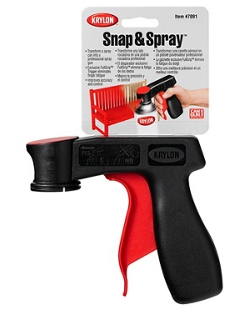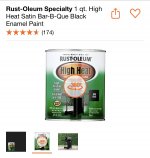Bruce
TVWBB 2-Star Olympian
WHAT: This HOW TO will show you how I paint my Genesis grill frames. This does not cover prepping the frames or anything like that. That is a whole other discussion. I am just showing you the method I use to actually paint the frames.
WHY: I have painted approximately 100 Genesis frames over the past 4 years or so and this is the method I found that is the quickest and most effective.
What You Need:
o A cleaned and prepped Genesis gas grill frame.
o A can of Rustoleum High Heat Ultra or similar spec'ed spray paint.
o A can of Rustoleum 2X Gloss or Semi-Gloss spray paint or similar.
o Something to stand the grill on up off the ground.
o For best results, read and follow painting recommendations for the paint you are using and make sure it is not a windy day.
General Overview: Start with the frame upside down. Then paint the underside and sides of the frame parts. This way, when you tip the frame right side up to paint the top, you won't have to worry about the object(s) (5 gallon pails) you set the grill on marking up the top of the grill. Then, you want to paint the area of the frame that is close proximity to the cook box with High Heat paint. Then move on to the other parts with the the 2X paint. You are painting the bottom and both sides of each frame piece at this point. Once that is done, you have to wait a while until the paint is dry to the touch, then you can carefully flip the grill upright and proceed to paint the top side of the frame which will complete the process of painting the frame. This should take about 10 minutes of actual paint time. You can always do a second coat, but unless the frame was in rough shape and you had to strip a lot of the old paint off prior to repainting, one coat should be fine. The original paint that Weber used is superior to the spray paint we use, so I tend to not strip any of it that I do not have to.
VIDEO: This video is full demonstration of the process I use to paint my Genesis grill frames. Enjoy. If you have any questions, let me know.
WHY: I have painted approximately 100 Genesis frames over the past 4 years or so and this is the method I found that is the quickest and most effective.
What You Need:
o A cleaned and prepped Genesis gas grill frame.
o A can of Rustoleum High Heat Ultra or similar spec'ed spray paint.
o A can of Rustoleum 2X Gloss or Semi-Gloss spray paint or similar.
o Something to stand the grill on up off the ground.
o For best results, read and follow painting recommendations for the paint you are using and make sure it is not a windy day.
General Overview: Start with the frame upside down. Then paint the underside and sides of the frame parts. This way, when you tip the frame right side up to paint the top, you won't have to worry about the object(s) (5 gallon pails) you set the grill on marking up the top of the grill. Then, you want to paint the area of the frame that is close proximity to the cook box with High Heat paint. Then move on to the other parts with the the 2X paint. You are painting the bottom and both sides of each frame piece at this point. Once that is done, you have to wait a while until the paint is dry to the touch, then you can carefully flip the grill upright and proceed to paint the top side of the frame which will complete the process of painting the frame. This should take about 10 minutes of actual paint time. You can always do a second coat, but unless the frame was in rough shape and you had to strip a lot of the old paint off prior to repainting, one coat should be fine. The original paint that Weber used is superior to the spray paint we use, so I tend to not strip any of it that I do not have to.
VIDEO: This video is full demonstration of the process I use to paint my Genesis grill frames. Enjoy. If you have any questions, let me know.



